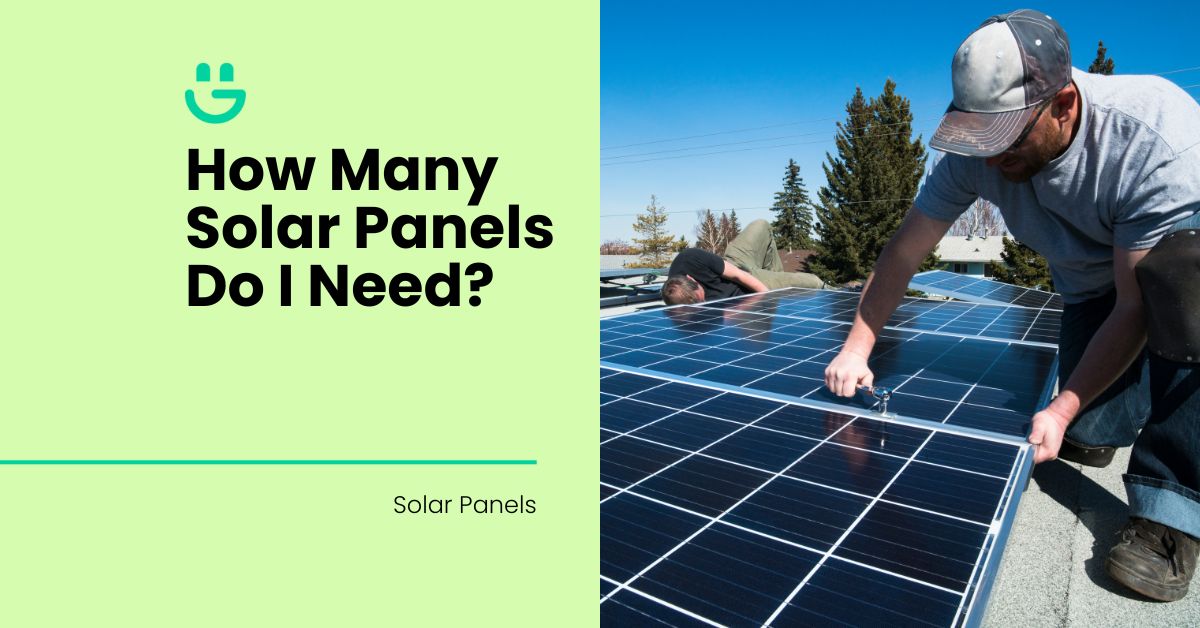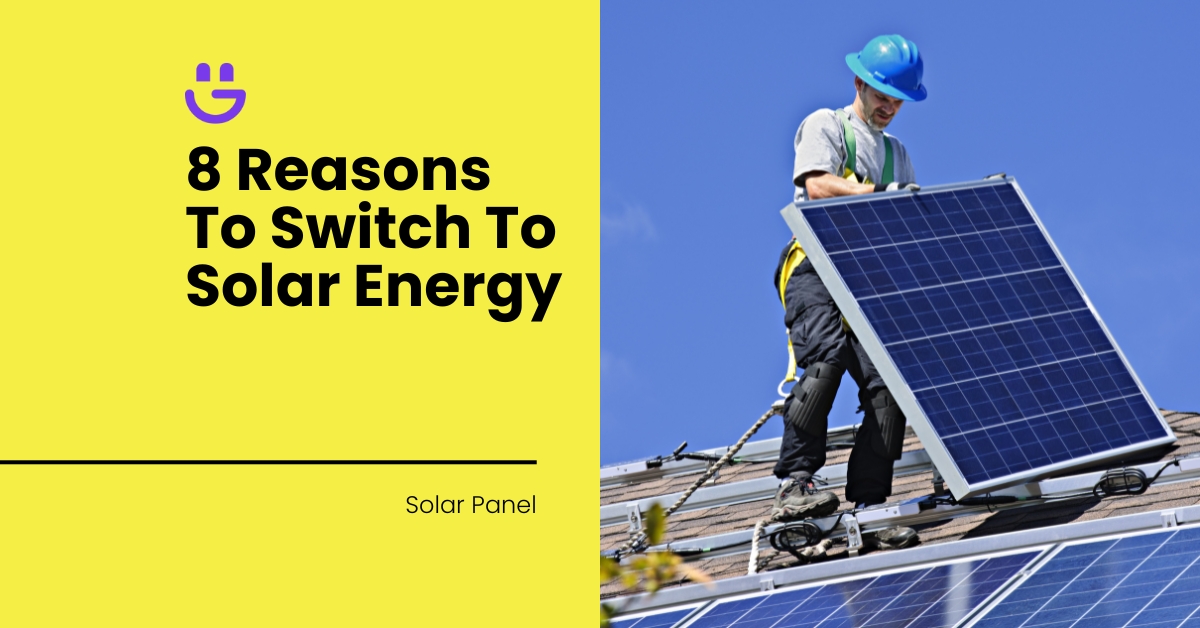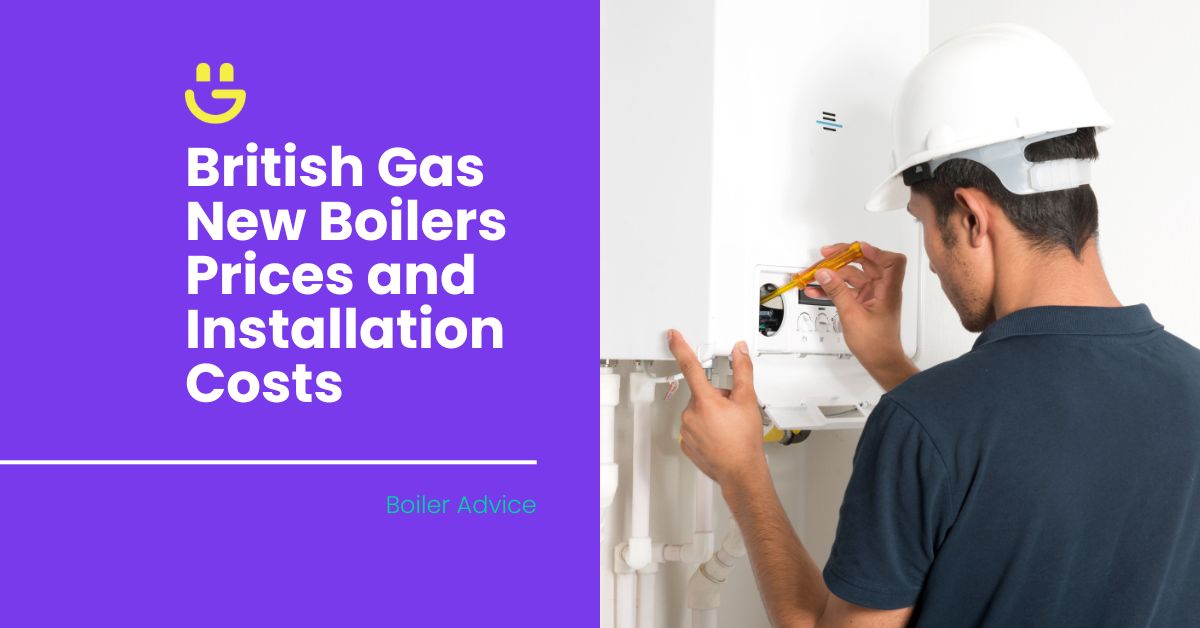Last Updated on July 26, 2024
If you’re considering installing solar, one of the first questions you’re likely asking yourself is “How many solar panels do I need?”. Some say the answer is between 15 and 25. However, the answer isn’t straightforward because there are plenty of factors you need to take into account. But once you assess your needs, it’s much easier to calculate.
We are Eco Happy – a one-stop solution for your home energy and heating needs. With years of experience on our side, we’re going to help you find the answer you’re looking for. This guide will give you insight into the average solar panel system you would need to suit your lifestyle and demands. We’ll also show you the various ways to calculate how many solar panels you need and what factors might influence your calculations.
Contents
Number Of Solar Panels Needed For UK Homes
Installing residential solar panels will save you on energy bills and contribute to a greener planet. But before you get there, the first mission is to do some calculations! This list will give you an average idea of how many solar panels a typical household might need.
1–2 bedrooms
A standard 1-2 bedroom house in the UK needs roughly 5 kWh of energy per day, based on 1-2 residents. A 2.5 kW system should be able to support most of your electricity needs.
2.5kW systems usually consist of 6 to 7 panels – depending on the panel wattage. As the number of people in your home increases, so does the need for more solar panels. However, the calculation should be based on your energy consumption, not the number of people.
2–3 bedrooms
More spacious homes have higher energy demands. The average daily electricity usage for 2-3 bedroom houses with the same number of people racks up to 8 kW. This means you’ll likely need a 3.5 kW system with 350W or 450W solar panels. A 3.5 kW system would then need between 7 and 10 panels.
4-5 bedrooms
4-5 bedroom homes with around five occupants use about 12 kW daily. In this case, you would need a powerful 5-6 kW system, which would end up requiring between 10 and 15 solar panels. This number is based on whether you use 350W or 450W efficiencies. Before you install solar panels, you should know that solar panel efficiencies influence the kilowatt output (we’ll cover this in a moment).
Costs
Cost is the number one reason people question whether solar panels are worth it. The price you’ll pay depends on the size and efficiency of your solar system. You’ll also need to factor in the costs of the other components, like inverters and batteries, alongside the installation.
Hypothetically, you can expect to pay around £2.70 per watt to install residential solar panels. You can multiply that amount by the number of solar panels you expect to install. This will give you a rough idea of the total installation bill.
For example: 4,000 watts x £2.70 = £10,800.
Number Of Solar Panels Needed For UK Businesses
Determining how many solar panels your business needs is a bit like solving a puzzle with many pieces. Factors like the size of your roof, how much power you use, and even when you use it all play a role.
Start by checking your electricity bills to see how much electricity you use and when you use it most. This gives you a starting point for figuring out how much energy your solar panels need to generate.
If you’re a research wizard and want an idea, you could read our next section to get an estimate on how many solar panels you need. You could use the energy usage or roof-space method to calculate. Remember that it would only be a generalised number.
Costs
With expert guidance, you can choose the right panels for your budget and needs. It’s all about finding the perfect fit for your business so you can start saving money and helping the environment.
If you’d like a hypothetical calculation on a solar panel installation, you could multiply your total solar panel wattage by £2.70.
How To Calculate How Many Solar Panels You Need
To figure out how many solar panels you need, you’ll need to grab your electricity usage data and know the size of your roof. You can estimate these data points, but the more precise it is, the better it is for an accurate calculation. Ready? Let’s discover your solar panel needs!
Energy consumption method
The most accurate way to get an idea of how many solar panels you need is by basing it on your energy usage and your area’s sunlight hours. This calculation figures out what size solar array you need. From there, you can figure out the amount panels you need to fit the array.
These are the two equations:
- (daily usage in kWh) ÷ (peak sunlight hours) = solar array in kWh
- (solar array in kWh) ÷ (solar panel wattage in kWh) = number of solar panels
Step 1
Have a look at your old utility bills to understand how much power your household typically uses. Divide your usage (in kWh) by 365 for yearly amounts (or monthly amounts by the number of days in that month). This will give you a daily average.
Step 2
To estimate your array, you’ll divide your household’s daily energy requirement by the peak sunlight hours for your area. A peak sunlight hour is an hour in which the intensity of sunlight averages 1,000 watts per square metre (sq m). The general peak sunlight hours in the UK are between 2 and 3.
Let’s say you live in Manchester, where your peak sunlight hours are 2.5, and your household uses 8 kWh a day. Your sum will look like this:
8 kWh ÷ 2.5 = 3.2 kWh array
This means you need enough panels to create a 3.2 kWh array.
Step 3
Now, to determine how many panels fit into that answer, you need to do the following calculation:
3.2 kWh ÷ (Solar panel wattage in kW) = number of solar panels you need
So let’s say you want to use 400-watt panels, your equation would be:
3.2 kWh ÷ 0.4 kW = 8 solar panels required
Step 4
You can round up the number of solar panels – if needed. Also, you can decrease the number of solar panels you need by upping your choice of panel wattage.
Roof space method
The energy consumption calculation might figure out your exact needs, but it doesn’t account for how much roof space you have for the panels. To figure out how many solar panels you can fit on your roof, you need to consider your roof size and any obstacles, like skylights, that take up space.
This equation will help:
- (available roof area) ÷ (area needed for a single solar panel) = number of solar panels
Step 1
Start by calculating your total roof area, then subtract the space taken by obstacles.
Step 2
Divide by the area the solar panel would take.
Solar panels have become smaller but more efficient in recent times. In the UK, a solar panel is usually 1.7 sq m, but you must leave some clearance around them to comply with safety regulations. Generally, you could count the solar panel area as an average of 2.4 sq m.
Let’s say your roof area is 50 sq m, and you divide that by 2.4 sq m. This means you can accommodate around 12 solar panels.
Online calculators
If the previous two calculations still leave you asking the question “How many solar panels do I need?”, then an online solar panel calculator might help. Some websites use mapping technology to find your home and take accurate measurements. This can be a great indication of your actual roof capacity and validate your calculations.
An online mapping tool is especially helpful if you’re not in the mood to climb onto your roof to measure it!
Hiring a professional
Installing solar panels is no simple feat. The absolute best way to get an accurate calculation of how many solar panels you need is to control a solar panel installer, like Eco Happy. It is our job to evaluate your needs and find the best and most cost-effective solutions. With our help, you’ll save on your energy bills in no time.
Factors That Influence Your Solar Panel Needs
When you consider how many solar panels you need, there are several important factors to think about. Each of these aspects can play a significant role in your calculations and make all the difference in meeting your specific needs.
Electricity usage
You have to understand your needs to meet them. By analysing your past electricity bills, you can gain valuable insights into how much energy your home consumes on average. Your monthly and annual electricity usage is a fundamental starting point for determining the size and scope of your solar system.
House size
The larger your house is, the more power you need. You can use the number of rooms for guidance, like the examples from earlier. Although the number of rooms is an influencing factor, that estimated wattage is a general guideline. It would be best to base your solar panel installation on usage rather than square meterage.
Number of people
With more people living in your home, there are extra rooms to light up, showers to warm, and bundles of washing to do. All this adds to your wattage demand. You may be 5 people living in a 4-bedroom home. Therefore, an extra panel above the 4-bedroom average may be necessary to keep up with your lifestyle. It may seem minor, but one panel makes a huge impact overall.
The type of solar panel
There are numerous types of solar panels on the market, each with its benefits. Some might be more efficient, while others are cheaper. One important thing to note is that physical size does not mean much in terms of power. The wattage and efficiency do. You need to look into the effectiveness of your options to get the most out of fewer panels.
Solar panel outputs
An average residential solar panel has an output rating of 250W, 300W, 350W, or 400W. Some options are over 400W, but they are less common. The higher the output is, the more solar energy it produces.
How much electricity a panel generates varies according to the sun exposure and its efficiency. The main thing to take into account about output is that a singular high-wattage solar panel takes up far less space than many solar panels with less wattage.
Solar panel efficiency
Solar panel efficiency refers to the amount of sunlight a panel can convert into usable electricity. This depends on the type of solar panel you choose. The efficiency you choose will likely depend on your budget and the balance between output and the quality of the panel.
The three main types of solar panels are:
- Monocrystalline: These solar panels are made with pure silicon and are considered the most efficient. They are typically expensive but tend to have a longer lifespan.
- Polycrystalline: This option consists of melted silicon particles and is the second-most energy-efficient. They are also on the pricier side, but less so than monocrystalline solar panels.
- Thin-Film: They are made with layers of different materials, including some silicon. They are a less efficient option, with a shorter lifespan, but have a more attractive price point.
Check out our expert guide on how to choose the right solar panels for your home.
Roof size and orientation
The way your solar panels face can affect how much energy they produce. If you’re in the UK, panels facing south usually generate the most electricity. That’s because they get the most sunshine during the day. Panels facing north, east or west can still work well for solar, but they won’t make as much electricity.
Here’s the kicker: If you only have space for solar panels on a north-facing roof, you might need to increase the number of panels in your array to compensate for the lack of sunlight.
Geographic location
Some areas in the UK get more sun throughout the year than others. If you put the same roof and system in Sussex and Greater Manchester, the solar panel system in Sussex will generate far more electricity. This is simply because there are more annual sunshine hours in Sussex.
Another geographical concept that we’ve touched on is peak sunshine hours. Professionals installing solar panels take this into account when determining how many you need.
Why are peak hours essential? This light-intensity measurement gives you an amount of time that your solar system can maximise its electricity generation. It is also the number one indicator of whether you’ll be able to produce excess electricity for net metering.
To help with your calculations, these are some of the peak sunlight hours in the UK:
- Aberdeen, Belfast, Edinburgh, Glasgow: 2.4
- Kingston Upon Hull, Leicester, Manchester, New Castle Upon Tyne: 2.5
- Birmingham, Liverpool: 2.6
- Cambridge, Oxford: 2.7
- Bristol, London: 2.8
- Cardiff, Southampton: 2.9
- Plymouth: 3
FAQs
What is the biggest disadvantage of solar electricity?
The biggest disadvantage of solar power, especially in the UK, is the high cost of solar panels. From the costs of the units to the installation, there are various fees involved in making solar power possible. It also takes close to 14 years before solar panels pay off in terms of energy bill savings.
How many panels are in a 4 kW solar system?
A 4 kW array of solar panels is highly popular for residential properties, but the number of panels may vary between 10 and 16. It depends on the panel wattage. A 250W system will have 16, and a 400W system will fit 10. Another example is a 350W system, which would consist of 12 solar panels.
Why is solar not popular in the UK?
The main reason solar panels are not popular in the UK is because of their exorbitant costs. On average, a solar panel system for four people costs £6,000 – £8,000. The fact that there is only a maximum of three peak sunlight hours doesn’t help the cause either.
Will a 5 kW solar system run a house UK?
A 5 kW system is well-suited for a four-person household using around 13 kW of electricity a day. To work out if your solar array suits your home, multiply the system’s kW by the number of peak sunlight hours in your area. If the answer represents your daily energy usage, then it will be able to run your household.
How many solar panels do I need per person?
By dividing your total energy usage by the number of occupants, you can estimate your energy requirements and plan how many solar panels are needed to meet those needs. Calculating the average energy consumption per person in your household can be an eye-opener when planning a solar panel system.
Final Thoughts
How many panels you need is based on things like your electricity usage, peak sun hours, the number of people in your house, your roof size, and the solar panel’s efficiency. There are many ways to calculate your needs on your own, but professionals are the most accurate in assessing all the factors involved. Feel free to contact Eco Happy for all your solar needs!






James Elston
Boiler Expert
James Elston is the top boiler replacement and heating expert at Eco Happy. He has over 20 years of experience in the industry, focusing on Gas Safe boiler installations and offering home-heating and energy-saving solutions to homeowners across the UK. From sourcing the most energy-efficient combi boiler to providing specialist heating advice, James ensures that Eco Happy maintains the highest standards and best customer service.